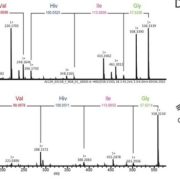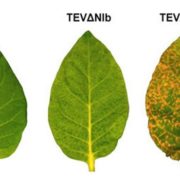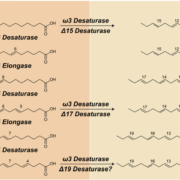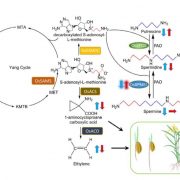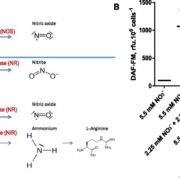Post-transcriptional regulation of nutrient transporters
Author: Stefanie Wege
ORCID: 0000-0002-7232-5889
Affiliation: ARC Centre of Excellence in Plant Energy Biology, PRC, School of Agriculture,
Food and Wine, Waite Research Institute, University of Adelaide, Waite Campus, Glen
Osmond 5064, South Australia, Australia
Most protein-coding genes in eukaryotes contain introns, and splicing of precursor mRNA (pre-mRNA) is an essential step in gene expression. This post-transcriptional step of gene regulation takes place in the nucleus, is highly conserved among eukaryotes, and involves the co-ordinated and specific activity of splicing factor proteins. Some splicing factors directly bind RNA, while others are involved in overcoming spatial and structural difficulties that are inherent to splicing events. For example, the animal Smu1, and its homologue RED, are splicing factors that aid in splicing of short introns. In addition to this general role in splicing, Smu1 and RED are involved in regulating alternative splicing (Spartz et al., 2004; Keiper et al., 2019). Similarly in plants, the two Smu1/RED homologues, SMU1 and SMU2, are crucial for the correct splicing of genes. SMU2 was first identified in maize (Zea mays), where loss-of-function leads to a variety of developmental defects in the endosperm, the embryo and meristematic tissues (Chung et al., 2007). A yeast-two hybrid screen using Arabidopsis (Arabidopsis thaliana) SMU2 (At2g26460) as bait then revealed SMU1 (At1g73720) as a protein interacting partner, and smu1 knockdown showed similar defects compared to smu2 (Chung et al., 2009). It was therefore proposed that SMU1 and SMU2 function as a complex to regulate splicing of pre-mRNA, and are mainly active in developmental tissues.
In this issue of Plant Physiology, Feng et al. (2020) now show that complex formation of SMU1 and SMU2 is not obligatory for the function of the proteins in splicing; and that SMU1/SMU2 mediated regulation of gene expression is important for magnesium (Mg2+) homeostasis. In a forward genetic screen, they identified plants hypersensitive to low Mg2+ that harbor a mutation in SMU1. They then show that the SMU1/SMU2 complex is crucial for the correct processing of pre-mRNA of the Mg2+ transporter MRS2-7 (At5g09690).
Previously, MRS2-7 was shown to have several alternatively spliced variants. Therefore, Feng et al. (2020) investigated the MRS2-7 mRNA in their smu1 mutant. They additionally included SMU2 in their studies and found that alterations in the SMU1/SMU2 complex lead to miss-spliced MRS2-7 variants that encode proteins lacking transporter activity, which ultimately renders the plants hypersensitive to low environmental Mg2+. In addition, Feng et al. (2020) could further demonstrate that, different to what was previously suggested (Chung et al., 2009), complex formation of SMU1 and SMU2 is not obligatory for their splicing activity. Over-expression of SMU1 in a smu2 knockout, and vice versa, restores the splicing of some introns in MRS2-7. Interestingly, the respective splicing activities of SMU1 and SMU2 are specific and loss of either homolog results in a different erroneous splicing pattern of MRS2-7 mRNA. Splicing within the nucleus occurs in nuclear speckles, which are defined subdomains with clear boundaries, separating them from other nuclear regions. Split-YFP assays, using SMU1 and SMU2 each tagged with a YFP-half, showed reconstitution of fluorescence in nuclear speckles. This suggests that stabilised SMU1 and SMU2 dimers localise in a spliceosomal complex and that dimerization ensures correct splicing of all introns (Feng et al. 2020).
The present study both shows insights into the interaction of two important splicing factors and a new insight into the control of Mg2+ transport. It is one of the few studies showing a direct connection of specific splicing factors and a nutrient transporter. We know from previous work looking at whole transcriptome changes that alternative splicing plays a critical role in nutrient homeostasis (Li et al., 2013; Dong et al., 2018), and further research might reveal more specific interactions. Other aspects of post-transcriptional regulation also play crucial roles. Mutations in the RNA processing protein complex THO/TREX, for example, have been shown to result in defective transcription termination at the often utilized NOS terminator (Khan et al. 2020).
These examples show that post-transcriptional regulation is complex, and its accuracy depends very often on nucleotide sequences outside of the coding sequence (CDS). DNA sequences outside of the CDS are often not present in transgenic plants expressing, for example, constructs of proteins of interest tagged with fluorescent proteins. The rapid advances being made in the use of CRISPR/Cas9 will hopefully allow us to easily integrate protein modifications, such as tags, into the original genome position soon. This will vastly decrease possible secondary effects through a loss of post-transcriptional regulation of our genes of interest.
Literature Cited
Chung T, Kim CS, Nguyen HN, Meeley RB, Larkins BA (2007) The maize Zmsmu2 gene encodes a putative RNA-splicing factor that affects protein synthesis and RNA processing during endosperm development. Plant Physiology 144: 821-835
Chung T, Wang D, Kim C-S, Yadegari R, Larkins BA (2009) Plant SMU-1 and SMU-2 Homologues Regulate Pre-mRNA Splicing and Multiple Aspects of Development. Plant Physiology 151: 1498-1512
Dong C, He F, Berkowitz O, Liu J, Cao P, Tang M, Shi H, Wang W, Li Q, Shen Z, Whelan J, Zheng L (2018) Alternative Splicing Plays a Critical Role in Maintaining Mineral Nutrient Homeostasis in Rice (Oryza sativa). The Plant Cell 30: 2267-2285
Keiper S, Papasaikas P, Will CL, Valcarcel J, Girard C, Luhrmann R (2019) Smu1 and RED are required for activation of spliceosomal B complexes assembled on short introns. Nature Communications 10
Khan GA, Deforges J, Reis RS, Hsieh Y-F, Montpetit J, Antosz W, Santuari L, Hardtke CS, Grasser KD, Poirier Y (2020) The transcription and export complex THO/TREX contributes to transcription termination in plants. Plos Genetics 16
Li W, Lin W-D, Ray P, Lan P, Schmidt W (2013) Genome-Wide Detection of Condition-Sensitive Alternative Splicing in Arabidopsis Roots. Plant Physiology 162: 1750-1763
Spartz AK, Herman RK, Shaw JE (2004) SMU-2 and SMU-1, Caenorhabditis elegans homologs of mammalian spliceosome-associated proteins RED and fSAP57, work together to affect splice site choice. Molecular and Cellular Biology 24: 6811-6823


